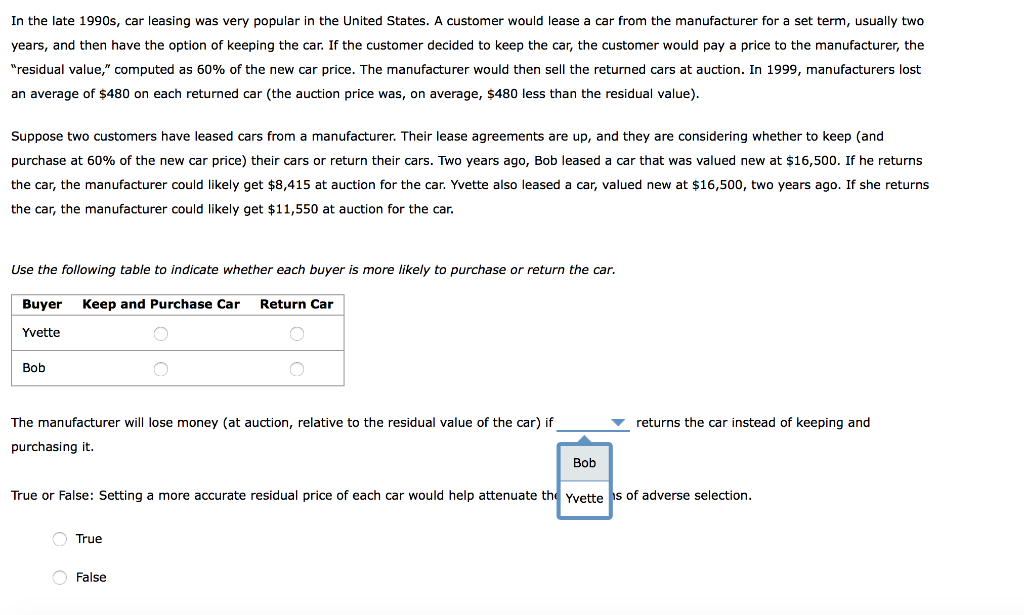In the late 1990s, car leasing was very popular in the United States. A customer would lease a car from the manufacturer for a set term, usually two years, and then have the option of keeping the car. If the customer decided to keep the car, the customer would pay a price to the manufacturer, the "residual value," computed as 60% of the new car price. The manufacturer would then sell the returned cars at auction. In 1999, manufacturers lost an average of $480 on each returned car (the auction price was, on average, $480 less than the residual value). Suppose two customers have leased cars from a manufacturer. Their lease agreements are up, and they are considering whether to keep (and purchase at 60% of the new car price) their cars or return their cars. Two years ago, Bob leased a car that was valued new at $16,500. If he returns the car, the manufacturer could likely get $8,415 at auction for the car. Yvette also leased a car, valued new at $16,500, two years ago. If she returns the car, the manufacturer could likely get $11,550 at auction for the car.
In the late 1990s, car leasing was very popular in the United States. A customer would lease a car from the manufacturer for a set term, usually two years, and then have the option of keeping the car. If the customer decided to keep the car, the customer would pay a price to the manufacturer, the "residual value," computed as 60% of the new car price. The manufacturer would then sell the returned cars at auction. In 1999, manufacturers lost an average of $480 on each returned car (the auction price was, on average, $480 less than the residual value). Suppose two customers have leased cars from a manufacturer. Their lease agreements are up, and they are considering whether to keep (and purchase at 60% of the new car price) their cars or return their cars. Two years ago, Bob leased a car that was valued new at $16,500. If he returns the car, the manufacturer could likely get $8,415 at auction for the car. Yvette also leased a car, valued new at $16,500, two years ago. If she returns the car, the manufacturer could likely get $11,550 at auction for the car.
Chapter19: Externalities And Public Goods
Section: Chapter Questions
Problem 19.12P
Related questions
Question
No written by hand solution

Transcribed Image Text:In the late 1990s, car leasing was very popular in the United States. A customer would lease a car from the manufacturer for a set term, usually two
years, and then have the option of keeping the car. If the customer decided to keep the car, the customer would pay a price to the manufacturer, the
"residual value," computed as 60% of the new car price. The manufacturer would then sell the returned cars at auction. In 1999, manufacturers lost
an average of $480 on each returned car (the auction price was, on average, $480 less than the residual value).
Suppose two customers have leased cars from a manufacturer. Their lease agreements are up, and they are considering whether to keep (and
purchase at 60% of the new car price) their cars or return their cars. Two years ago, Bob leased a car that was valued new at $16,500. If he returns
the car, the manufacturer could likely get $8,415 at auction for the car. Yvette also leased a car, valued new at $16,500, two years ago. If she returns
the car, the manufacturer could likely get $11,550 at auction for the car.
Use the following table to indicate whether each buyer is more likely to purchase or return the car.
Buyer Keep and Purchase Car Return Car
Yvette
Bob
The manufacturer will lose money (at auction, relative to the residual value of the car) if
purchasing it.
True
Bob
True or False: Setting a more accurate residual price of each car would help attenuate the Yvettes of adverse selection.
O False
returns the car instead of keeping and
Expert Solution
This question has been solved!
Explore an expertly crafted, step-by-step solution for a thorough understanding of key concepts.
This is a popular solution!
Trending now
This is a popular solution!
Step by step
Solved in 3 steps with 1 images

Knowledge Booster
Learn more about
Need a deep-dive on the concept behind this application? Look no further. Learn more about this topic, economics and related others by exploring similar questions and additional content below.Recommended textbooks for you

